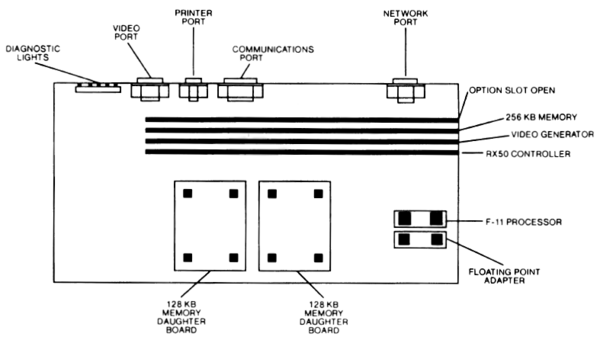Professional 300 Series
The Professional 300 Series is the family of DEC PDP-11 based Personal Computers.
The major difference to the "real" PDP-11s is that a motherboard is used instead of a backplane.
The second difference is that a Bit-mapped display is used instead of an ASCII Video terminal one.
The third difference is the CTI BUS (Computing Terminal Interconnect) bus, that is solely used on the PRO series.
The Professional came in three versions:
- Professional 325
- Professional 350
- Professional 380
The common system components are:
- VR201 Video Monitor (standard)
- LK201 Keyboard
- P/OS Professional 300 Operating System Software
- P/OS Software
Contents
ZIF Connectors
The Professional 300 Series computer use Zero insertion force (ZIF) connectors for its CTI modules.
Insertion:
- Hold the module by the zero insertion force (ZIF) connector and pull the handle out turning it 90° clockwise.
- Slide the module into the slot in the card cage. Turn the handle straight up and push it in toward the module.
Removal:
- Turn the handle 90° clockwise and pull it out.
- Carefully pull the module out of the card cage.
Professional 325 / Professional 350
The Professional 325 and the Professional 350 personal computers came out in 1982.
Both use the RX50 dual floppy drive and the PDP-11/23 chip set (F-11). They are equipped with 512 KB memory and a bit-mapped video controller (960 x 240 pixels)
Professional 325
The Professional 325 is the base model with only little expansion capabilities:
- You can only upgrade to a fixed disk by upgrading to a Professional 350, i.e. by installing a Professional 350 system board
- There is only one free slot for an CTI expansion module.
Professional 350
The Professional 350 comes with either an RD50 5 MB or an RD51 10 MB fixed disk.
There are four free CTI option slots for expansions.
With the Professional 350, up to one MB of memory can be added in increments of 256 KB. Each 256 KB memory option occupies one option slot.
It can be upgraded with the VC241-A Extended Bit-map Option (EBO), which adds two bit-map planes to the standard video generator for a total of three planes. Each plane supports a display of 960 x 240 pixels. In addition, the extended bit-map option adds a color output map that can simultaneously display on a color monitor eight colors from a palette of 256 colors. It displays eight of a possible 16 shades of gray on the monochrome monitor.
Note: The extended bit map module supports the 13-inch color monitor (VR241).
Professional 380
The model 380 was introduced in 1985, the main change was the PDP-11/73 chip set (J11) and a completely new mainboard.
Overview OF PRO 380 Differences from PRO 325/350
The Professional 380 is the newest member of the PRO 300 series. It differs from the Professional 350 in several ways. One of the most important of these is that it uses the more powerful J-11 processor chipset instead of the F-11 processor chipset. It also has increased graphics functionality in that it supports a new high resolution mode, and it offers a palette of 4,096 colors to choose from instead of the 256 available in the 350. The hardware layout is somewhat different: the first 512KB of memory resides on the system module, the base video subsystem is also on the system module, and the Extended Bitmap Option is a daughtercard on the system module. This means that there are additional slots available in the cardcage for options. P/OS V2.0A or higher is required for PRO 380 support.
PRO Operating Systems
| v • d • e PDP-11 Computers and Peripherals |
|---|
| UNIBUS PDP-11s - PDP-11/20 • PDP-11/15 • PDP-11/35 • PDP-11/40 • PDP-11/45 • PDP-11/50 • PDP-11/55 • PDP-11/70 PDP-11/05 • PDP-11/10 • PDP-11/04 • PDP-11/34 • PDP-11/60 • PDP-11/44 • PDP-11/24 • PDP-11/84 • PDP-11/94 QBUS PDP-11s - PDP-11/03 • PDP-11/23 • PDP-11/23+ • MicroPDP-11/73 • MicroPDP-11/53 • MicroPDP-11/83 • MicroPDP-11/93 QBUS CPUs: LSI-11 • LSI-11/2 • KDF11-A • KDF11-B • KDJ11-A • KDJ11-B • KDJ11-D • KDJ11-E Buses: UNIBUS • UNIBUS map • SPC • MUD • EUB • QBUS • CD interconnect • PMI Also: PDP-11 architecture • PDP-11 Extended Instruction Set • FP11 floating point • PDP-11 Memory Management |
| UNIBUS CPUs: KA11 • KC11 • KB11-A • KB11-B • KB11-C • KB11-D • KD11-A • KD11-B • KD11-D • KD11-E • KD11-EA • KD11-K • KD11-Z • KDF11-U
Co-processors: FP11-A • FP11-B • FP11-C • FP11-E • FP11-F • KE44-A • FPF11 Chips: LSI-11 • KEV11-A • KEV11-B • KEV11-C • F-11 • KEF11-A • KTF11-A • T-11 • J-11 • FPJ11 CPU options: KE11-E • KE11-F • KJ11-A • KT11-C • KT11-D • KK11-A • KK11-B • KT24 • KTJ11-B Rare CPU options: KS11 Memory Protection and Relocation option • KT11-B Paging Option • KUV11 Writeable Control Store Front panels: KY11-A • KY11-D • KY11-J • KY11-LA • KY11-LB • KY11-P More on buses: UNIBUS and QBUS termination • Bus Arbitration on the Unibus and QBUS • CTI BUS PDT-11s - PDT-11/110 • PDT-11/130 • PDT-11/150 CTI PDP-11s - PRO-325 • PRO-350 • PRO-380 Other: FIS floating point • PDP-11 Commercial Instruction Set • PDP-11 stacks • PDP-11 family differences |


